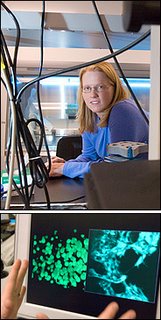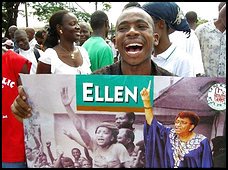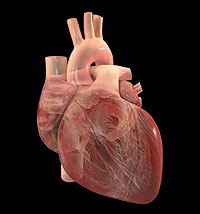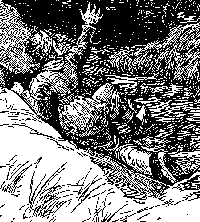Factory for human beeings







In a previous article, we set our ethics position around obtaining cells stem (CS), for end of cloning or tissue reproduction, disputing that they acquired from human embryos, infringed the ethics norms, as in the meantime these products, obtained from random genetic crossing, were unique and unrepeatable constructions. Each time that an investigator obtains CS, of the solid internal bulk of an early human embryo, destroying the remainder of the blastocist, is murdering to potential Einteins, Gandhis, Mothers Teresas, Da Vincis, Galileos, etc. We prefer to work with CS, obtained of alternate sources: replication of CS, obtained from one blastomere eradicated of a human blastocist–leaving to continue the remainders 7, its natural course, CS of nuclei of skin cells, CS of bone marrow, etc.
Now it so happens that Woo Suk Hwang, the south korean veterinary that cloned human beings with success (to which permitted to progress alone to a specific number of cells) and does the same with the dog Snupy, resulted to be a liar. Although now, Woo Suk, recognizes he employed human embryos generated from ovums donated by young researchers to its charge (some of which would have been coertioned and/or received strong sums of money), he had denied all previous things to the magazine Nature, in 2004. Yesterday, an it dismayed Woo Suk, after apologizing to all the world, resigned to all his main academic positions in Korea. “…The desire to emphasize and to gain pre-eminence carried me to lie…”. A little humility, in mouth of someone to whom will be very dificcult to believe, from now on.








5 days ago El Comercio, inaugurated a debate around the problematic one of Peruvian Health. Made a speech: 8 doctors. Concerning the problematic and diagnosis, it was to state the proppings and promotion of cosmovisions of cure medicine, personal points of view (like how happened them in its previous managements), few nexuses with the binomials: health-education, health-peruvian enviromment, with the society per se. Short aims proposals, with more of the same, with many empties to fill. I will emphasize some discussed proposals, adding others of extreme importance. 1) INCREASE OF THE BUDGET. As we have already specified it in previous articles, our proposal is: Educatión=20%, Health=15% and Housing = 15%, of the total National Budget of the Peru. Any bottom destined to divergent headings (Ministry of the Woman, Executive and others), must be redirected to these 3 headings, that locate the peruvian person like beneficiary and supreme aim of the efforts of our country. 2) TO PRIORITIZE THE PREVENTIVE MEDICINE. To the doctor one is due to pay to him not to cure to 1 patient, but to prevent that the disease settles in the community. Equipment integrated by 1 educator, 1 obstetrician, 1 pediatrics, 1 general physician and 1 psycologist must to make weekly visits to all and each one of the ordered families, we say to the all inhabitants of 5 specific blocks /each health preventive group. The physician must watch in situ, that all the children are vaccinated, with appropriate dental health, with suitable diets, the state of familiar violence, practicing sport promoters of health, state of water networks, disposal, light, pediatric and pregnacy woman health. Where it was necessary, the doctor, must establish fast connections to slugs or, hospitals. The expenses of transport, posters, instructions to leave, food and salaries must be paid in a 50%, by the users (urban families, rural groupings) or, privates ONGs and the 50% rest by the regional governments or the central state. In this heading, the Ministry of Health of Peru (MINSA), must to have right to a total veto, to the operation of industries that contaminate the enviromment. More soon of which we pruned to anticipate, most countries will bet by a densificatión of their sanitary preventive systems. 3) TO QUESTION Or TO REORIENT, the CONTINUOUS CONSTRUCTION OF GREAT HOSPITALS, like medical model to follow. To necessity of our country as a whole, the hospitals (curatives, all), single constitute a small fraction of our necessities, consuming at the moment but of which they contribute. I have seen in some cities of Peru, true white elephants (hospitals with empty beds), worked to luck of asylums of old, hotels, inns of narcotics traffickers or delinquents of necktie, hosting of leafy bureaucracies. Around 1995 - in a great hospital of EsSalud (Social Security), one can observe 4 orientation people :2 lift attendants to raise and other 2 to lower, where single must to have one. We need that if, a network -all over our country- of modern buildings for Blood donation points, other buildings not so modern -but although spaced-, for pregnancy women with 1 or, 2, operating urgency rooms, buildings of attention for pediatric emergencies (seizures, asthma, burns), with fast returns (24-48 hs), of patients to its homes for its final recovery, avoiding to acquire hospital infections, time and money savings; politraumatizaded areas of emergency, etc. The buildings, slugs, networks or hospitals must be constructed single to demand, for which would be necessary to know in detail the epidemiologic profile of each region. 4) IMMUNIZATIONS. It matters nonsingle to obtain national cover in the already well-known programs of immunization, but to add others; all the possible vaccines. He is high-priority, to develop and to implement bovine that chokes prevalentes buds, epidemics and diseases in ours pais (malaria, dengue, bartonelosis, yellow fever, hepatitis, all the range of virales affections). To establish relations of investigation and vaccine production with algun related Latin American Center, to acquire the vaccines that we need, without timerosal of by means, of course 5) FUSION of HOSPITALS. Near the area where I work exist 3 hospitals (MINSA+ESSALUD), with but of 600 beds, struggling each one, to count on the best cardio-surgical centers. If the 3 hospitals merged, 2 must be exceeding. Aside from this wastefulness, I observe of continuous tents of MINSA and ESSALUD, sheltering and offering medical attention to little passages of its main constructions, like saying: I am offering preventive medicine. But, to 100 meters of its headquarters?. In addition, all know that Social Security is the small box to which few governments resort when lack money. The speakers did not speak to fuse or to integrate in a whole, to the exclusive hospitals of Navy, Army, Aviation, Police Forces, etc. We would save much with the single existence of 2 types of hospitals, the fused ones of the state with excrescences for military effects and, the private hospitals. 6) UNIVERSAL INSURANCE. According to the Head of EsSalud, today single 2.3 million of Peruvian contribute actively. If the Universal Insurance were implanted (27 million of Peruvian), it would be had enormous amounts of money, with personal contributions very reduced, may be 1 dollar /month/each/people. It is necessary to make fast this insurance, founded on solidarity (healthy of today supporting to ill brothers). 7) SAFE And CHEAP DRUGS. It is known, that the best drug is that than cures without producing side effects. In this perspective, betting by preventive methods and natural drugs have value. If there is money no to acquire mark medicines, it is necessary to bet by generic but the important ones (antibiotics, hormones, antinflamatories, hidratants). In order to lower the price of costs, contacts with great Chinese, Latin American or hindues laboratories can be established. Where it agrees they can prioritize master formulas pharmaceutically skillful prepared by local pharmaeutics. After all, today it is accepted in the pharmacologic world, that single has proven value, those drugs elaborated to the measurement (of a person or racial group) and not the generalist them, that are sold massively at the moment. It matters, to incorporate natural medicine concepts (medicine elaboration taking as it bases gone away therapeuticos principles of our own organism) and vegetal principles of use validated by medical science. 8) BABY-MOTHER HEALTH. It is necessary to change the frame according to which, many obstetricians and pediatricians waits for newborn and pregnancy women, by another one in which the professionals mobilize themselves towards the mountain (homes), daily. The conceived one, structuring itself in the belly of all Peruvian mother, must be the priority number 1, over all the other things in our country. Baby-mother health, nonsingle is to take care of the mother and the boy, during the childbirth. The concept must include the later care until the 12 years, involving cultural aspects. In this sense it is inconceivable that a Peruvian boy goes to the school, not providing him all which he requires : corresponding breakfast and attached preparations. 9) I finish saying that most Peruvian hospitals shines by ABSENCE of DEMOCRACY,in its MANAGEMENT. Being the patients the reason of being of our curatives hospitals, calls the attention that the patients, lack seats in the High Direction of the hospital, in such a way, that their can make complaints, right to veto certain procedures (with absent informed consents), to denounce the extreme slowness of certain procedures, being dealt with ethics and respect, receiving the last advances of medicine, being deserving to all the possible and opportune information. Of another side, the directors of the hospitals must be chosen by representatives of the regional governments, the central, the patients, the medical associations, the unions and nonsingle government with the object of confidence relations, since it is made at the moment. |
1) INCREMENTO DEL PRESUPUESTO. Como ya lo hemos explicitado en articulos anteriores, nuestra propuesta es : Educación=20%, Salud=15% y Vivienda =15%, del total del Presupuesto Nacional del Peru. Cualquier fondo destinado a rubros divergentes (Ministerio de la Mujer, Ejecutivo y otros),deberian ser redireccionados a estos 3 rubros, que ubican a la persona como beneficiario y fin supremo de un pais.
2) PRIORIZAR LA MEDICINA PREVENTIVA. Al médico se le debe pagar no por curar a 1 paciente, sino por impedir que la enfermedad se instale en la comunidad. Equipos integrados por 1 educador, 1 obstetra,1 pediatra, 1 medico general y 1 psicologo deberian realizar visitas semanales a todas y c/una de las familias encargadas, digamos a las habitantes de unas 5 cuadras/grupo evaluador. El medico vigilaria in situ, que todos los niños estén vacunados, con apropiada salud dental, con dietas adecuadas, el estado de violencia familiar, con practicas deportivas promotoras de salud, estado de redes de agua, desague, luz, salud pediátrica y de gestantes. Donde fuese necesario, el médico, estableceria luego, conexiones a postas u, hospitales. Los gastos de transporte, afiches, instrucciones a dejar, refrigerios y estipendios serian pagados en un 50%, por los usuarios (familias urbanas, agrupaciones rurales)u, ONGs privadas y el 50% restante por los gobiernos regionales o el estado. En este rubro, el Ministerio de Salud del Peru (MINSA), deberia tener derecho a veto total, al funcionamiento de industrias que contaminen el medio ambiente. Más pronto de lo que podamos prever, la mayoria de los paises apostarán por una densificación de sistemas preventivos sanitarios.
3) CUESTIONAR O REORIENTAR, LA CONTINUA EDIFICACIÓN DE GRANDES HOSPITALES, como modelo médico a seguir. A necesidad del pais en su conjunto, los hospitales (curativos, todos), solo constituyen una pequeña fracción de nuestras necesidades, consumiendo actualmente mas de lo que aportan. He visto en algunas ciudades del Peru, verdaderos elefantes blancos (hospitales con camas vacias), funcionado a suerte de asilos de ancianos, hoteles, hostales de narcotraficantes o delincuentes de corbata, cobijadoras de frondosas burocracias. Alrededor de 1995 -en un gran hospital de EsSalud- uno podia observar 4 personas orientadoras de usuarios:2 ascensoristas para subir y otras 2 para bajar, donde solo debia haber una. Necesitamos eso si, una red –a lo largo y ancho del pais-de modernos edificios para Bancos de Sangre, otros edificios no tan modernos -pero si bien espaciados-, para gestantes con 1 o, 2, salas de operaciones de urgencia adjuntas, módulos de atención para emergencias pediátricas (convulsiones, asma, quemaduras), posibilitadoras de retornos rápidos (24-48 hs), de pacientes a sus hogares para su recuperación final, evitando adquirir infecciones nosocomiales, tiempo de estadia y dinero; areas de emergencia para politraumatizados, etc. Los módulos, postas, redes u hospitales deberian ser construidos solo a demanda, para lo cual importaria conocer en detalle el perfil sanitario-epidemiologico de cada región.
4) INMUNIZACIONES. Importa no solo lograr cobertura nacional en los programas de inmunizacion ya conocidos, sino agregar otros; todas las vacunas posibles. Es prioritario, desarrollar e implementar vacunas que sofoquen brotes, epidemias y enfermedades prevalentes en nuestro pais (malaria, dengue, bartonelosis, fiebre amarilla, hepatitis, toda la gama de afecciones virales). Establecer relaciones de investigación y producción de vacunas con algun Centro Latinoamericano relacionado , para adquirir las vacunas que nos faltan, sin timerosal de por medio, por supuesto
5) FUSION DEHOSPITALES. Cerca del area donde trabajo funcionan 3 hospitales (MINSA+ESSALUD), con mas de 600 camas, pugnando c/uno, por contar con los mejores centros cardio-quirúrgicos. Si se fusionaran los hospitales, 2 saldrian sobrando. Aparte de este despilfarro, observo de continuo carpas del MINSA y ESSALUD, cobijando y brindando atención médica a escasos pasos de sus edificaciones principales, como decir : estoy brindando medicina preventiva. ¿Pero, a 100 metros?. Además, todos saben que Seguridad Social es la caja chica a la que recurren no pocos gobiernos. Los panelistas no hablaron de fusionar o integrar en un todo, a los exclusivos hospitales de la Marina, Defensa, Aviación, Fuerzas Policiales,etc. Ahorrariamos mucho con la existencia de solo 2 tipos de hospitales, los fusionados del estado con excrecencias para efectos militares y, los hospitales privados.
6) SEGURO UNIVERSAL. Según el Jefe de EsSalud, hoy solo 2,3 millones de peruanos aportan activamente. Si se implantase el Seguro Universal (27 millones de peruanos), se dispondría de enormes cantidades de dinero, con aportes muy reducidos, tal véz 1 dólar /mes /persona. Hay que agilizar este seguro, fundado en la solidaridad (sanos de hoy apoyando a hermanos enfermos).
7) FARMACOS SEGUROS Y BARATOS. Es sabido, que el mejor fármaco es aquel que cura sin producir efectos colaterales. En esta perspectiva, el apostar por metodos preventivos y fármacos naturales tiene valor. Si no hay dinero para adquirir medicamentos de marca, hay que apostar por los genéricos mas importantes (antibioticos, hormonas, antinflamatorios, hidratantes). Para abaratar costos, se pueden establecer contactos con grandes laboratorios latinoamericanos chinos o, hindues. Donde convenga pueden priorizarse pocimas magistrales preparadas por farmaceuticos locales. Después de todo, hoy se acepta en el mundo farmacologico de elite, que solo tienen valor probado, aquellos fármacos elaborados a la medida (de una persona o grupo racial) y no los generalistas, que se expenden masivamente actualmente. Importa, incorporar conceptos de medicina natural (elaboración de medicamentos tomando como base principios terapeuticos extraidos de nuestro propio organismo) y principios vegetales de uso validado por la ciencia medica.
8) MADRE NIÑO. Hay que cambiar el marco según el cual, muchos obstetras y pediatras esperan comodamente a gestantes y neonatos, por otro en el que los profesionales se movilicen hacia la montaña, cotidianamente. El concebido, estructurándose en el vientre de toda madre peruana, debe ser la prioridad numero 1, por encima de todas las demás cosas en nuestro pais. Salud madre niño, no solo es atender a la madre y al niño, durante el parto. El concepto debe abarcar el cuidado ulterior hasta los 12 años, involucrando aspectos culturales. En este sentido es inconcebible que un niño peruano acuda a la escuela, no proporcionándosele alli (al que lo requiera), el desayuno y aprestos adjuntos correspondientes.
9) Por ultimo, en la mayoria de hospitales peruanos brilla por su AUSENCIA, LA GESTION EN DEMOCRACIA. Siendo los enfermos la razón de ser de los hospitales curativos, llama la atención que los pacientes, carezcan de asientos en la alta Direccion del hospital, de modo tal, que puedan viabilizar sus quejas, vetar ciertos procedimientos (con consentimientos informados ausentes), denunciar la extrema lentitud de ciertos procedimientos, ser tratados con ética y respeto, con los ultimos avances de la medicina, ser merecedores a toda la información posible y oportuna. De otro lado, los directivos de los hospitales deberian ser elegidos por representantes de los gobiernos regionales, del gobierno central, de los pacientes, de las agremiaciones medicas, de los sindicatos y no solo a efectos de relaciones de confianza, como se hace actualmente.Leer mas: